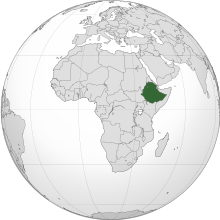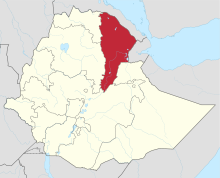User:JosephMohan/sandbox
 | This is a user sandbox of JosephMohan. You can use it for testing or practicing edits. This is not the sandbox where you should draft your assigned article for a dashboard.wikiedu.org course. To find the right sandbox for your assignment, visit your Dashboard course page and follow the Sandbox Draft link for your assigned article in the My Articles section. |
This is a user sandbox
Hadar Formation
[edit]| Hadar Formation | |
|---|---|
| Stratigraphic range: Pliocene | |
| Area | Afar Region |
| Lithology | |
| Primary | Paleosols, sands, clays, diatomite |
| Other | Lacustrine limestone and dolomite |
| Location | |
| Region | Afar, Ethiopia |
| Country | Ethiopia |
| Type section | |
| Named for | Hadar Village, Ethiopia |
The Pliocene Hadar Formation is a geologic unit that was deposited about 3 million years ago in the Afar Triangle of Ethiopia[1]. The formation is remarkable for the many fossil hominid specimens that it contains. The most famous of which is the iconic Australopithicus afarensis specimen 'Lucy'[2].
Location
[edit]
Geographically, the Hadar Formation is contained within the Afar Region of Ethiopia. From a geologic context, the Hadar Formation is located in the Afar Triangle which is at the northern end of the East African Rift Valley.[3] The Hadar Formation crops out of the plains in the Awash River Valley.[4]

Stratigraphy
[edit]The Hadar Formation comprises the region's sedimentary sequences from 3.4 - 2.3 Ma. These strata are comprised primarily of paleosols that were deposited in floodplains, sands and sandstone deposited in river deltas, and lacustrine clays, and diatomite beds of deep lake phases.[5][6] The Hadar Formation is divided into four members that are divided by prominent volcanic tuff layers. The Basal Member lies directly on top of the Afar basalts that are 4.5 Ma. The top of the Basal member is defined by the Sidi Hakoma Tuff and is dated to 3.4 Ma. The Sidi Hakoma Member overlies the Basal Member and is capped by the Triple Tuff which is dated to 3.22 Ma. The Denen Dora member lies above the Triple Tuff and is capped by the Kada Hadar Tuff which is dated to 3.175 Ma. The Kada Hadar Member lies on top of the Kada Hadar Tuff. The Kada Hadar Member contained AL 288-1 'Lucy'. The top of the Kada Hadar Member is loosely defined as being capped by conglomerate beds with prominent tuff layers that are dated to ~2.3 Ma.[7] These conglomerate beds tend to lay unconformably on the Hadar Formation. The unconformity at the top of the Hadar Formation makes it difficult to document the geologic history of this area from ~2.9 - 2.3 Ma.[4]Recent investigation has suggested that the Busidima Formation may directly overlay the Hadar Formation. The Busidima Formation has been dated to ~2.7 Ma.[4]

Paleontology
[edit]Floral and faunal lists of the organisms that were fossilized and have been recovered and cateloged from the Hadar Formation are compiled below. These species represent a small fraction of the organisms that would have lived in the region at the time the Hadar Formation sediments were being deposited. Ongoing research in the region is sure to reveal more species each season. this list is neither comprehensive nor up-to-date.
Flora
[edit]Phylum: Bacillariophyta
Class: Cosconodiscophyceae
Order: Aulacoseirales
Family: Aulacoseiraceae

Order: Coscinodiscales
Family: Coscinodiscaceae
- Lindavia cohenii[6]
Fauna
[edit]Phylum: Chordata
Class: Mammalia
Order: Artiodactyla
Family: Bovidae
- Syncerus [9]
- Tragelaphus sp.[9]
- Cephalophini sp. [9]
- Hippotragini sp. [9]
- Reduncini sp. [9]
- Parmularius sp.[9]
- Beatragus sp.[9]
- Raphicerus sp.[9]
- Gazella sp.[9]
- Gazella praethomsoni[9]
Family: Giraffidae
Family: Suidae
Order: Carnivora
Family: Herpestridae
Order: Primates
Family: Cercopithecidae
Family: Hominidae
Order: Proboscicea
Family: Eliphantidae
Order: Rodentia
Family: Thryonomidae
Family: Hystricidae
- Hystrix cristatus
Family: Muridae
Class: Reptilia
Order: Crocodilia
Family: Gavialidae
Archeology
[edit] | |
| Geographical range | Afro-Eurasia |
|---|---|
| Period | Lower Paleolithic |
| Dates | 2.6 million years BP – 1.7 million years BP |
| Major sites | Olduvai Gorge |
| Preceded by | Lomekwian |
| Followed by | Acheulean, Riwat |
Stone tools found in the Hadar Formation are characteristic of and classified as Oldowan. In the Hadar formation they are made from volcanic and sedimentary rocks, typically that of chert and basalt. The source of these tools tend to be from cobble sized river rocks.[9]
References
[edit]- ^ "Tephrostratigraphy and depositional environment of young (". Journal of African Earth Sciences. 112: 234–250. 2015-12-01. doi:10.1016/j.jafrearsci.2015.09.018. ISSN 1464-343X.
- ^ Johanson, Donald C.; Taieb, Maurice; Coppens, Yves (1982-04-01). "Pliocene hominids from the Hadar formation, Ethiopia (1973-1977): Stratigraphic, chronologic, and paleoenvironmental contexts, with notes on hominid morphology and systematics". American Journal of Physical Anthropology. 57 (4): 373–402. doi:10.1002/ajpa.1330570402. ISSN 1096-8644.
- ^ Feibel, Craig S.; Christopher J. Campisano (2004). "Sedimentary Patterns in the Pliocene Hadar Formation, Afar Rift, Ethiopia".
- ^ a b c DiMaggio, Erin N.; Arrowsmith, J Ramón; Campisano, Christopher J.; Johnson, Roy; Deino, Alan L.; Warren, Mark; Fisseha, Shimeles; Cohen, Andrew S. (2015-12). "Tephrostratigraphy and depositional environment of young (<2.94 Ma) Hadar Formation deposits at Ledi-Geraru, Afar, Ethiopia". Journal of African Earth Sciences. 112: 234–250. doi:10.1016/j.jafrearsci.2015.09.018. ISSN 1464-343X.
{{cite journal}}: Check date values in:|date=(help); no-break space character in|title=at position 64 (help) - ^ Campisano, Christopher (2008). "Depositional environments and stratigraphic summary of the Pliocene Hadar Formation at Hadar, Afar Depression, Ethiopia" (PDF). in Quade, J., and Wynn, J.G., eds., The Geology of Early Humans in the Horn of Africa: Geological Society of America Special Paper: 179–201.
- ^ a b c d MOHAN, JOSEPH; STONE, JEFFERY R.; CAMPISANO, CHRISTOPHER J (2016-09-02). "Three novel species of Bacillariophyta (Diatoms) belonging to Aulacoseira and Lindavia from the Pliocene Hadar Formation, Afar Depression of Ethiopia". Phytotaxa. 272 (4). ISSN 1179-3163.
- ^ Yemane, Tesfaye, "Stratigraphy and sedimentology of the Hadar Formation Afar, Ethiopia " (1997). Retrospective eses and Dissertations. 11577. h p://lib.dr.iastate.edu/rtd/11577
- ^ Tiercelin, J. J. (1986-01-01). "The Pliocene Hadar Formation, Afar depression of Ethiopia". Geological Society, London, Special Publications. 25 (1): 221–240. doi:10.1144/GSL.SP.1986.025.01.19. ISSN 0305-8719.
- ^ a b c d e f g h i j k l m n o p q r s t Kimbel, W. H. "Late Pliocene Homo and Oldowan Tools from the Hadar Formation (Kada Hadar Member), Ethiopia". Journal of Human Evolution. 31: 549–561.
- ^ Geraads, Denis; Alemseged, Zeresenay; Bobe, René; Reed, Denné (2015-07). "Pliocene Carnivora (Mammalia) from the Hadar Formation at Dikika, Lower Awash Valley, Ethiopia". Journal of African Earth Sciences. 107: 28–35. doi:10.1016/j.jafrearsci.2015.03.020. ISSN 1464-343X.
{{cite journal}}: Check date values in:|date=(help) - ^ a b c Frost, Stephen R.; Delson, Eric (2002-11). "Fossil Cercopithecidae from the Hadar Formation and surrounding areas of the Afar Depression, Ethiopia". Journal of Human Evolution. 43 (5): 687–748. doi:10.1006/jhev.2002.0603. ISSN 0047-2484.
{{cite journal}}: Check date values in:|date=(help) - ^ Kimbel, William H.; Johanson, Donald C.; Rak, Yoel (March 1994). "The first skull and other new discoveries of Australopithecus afarensis at Hadar, Ethiopia". Nature. 368 (6470): 449–451. doi:10.1038/368449a0. ISSN 0028-0836.
